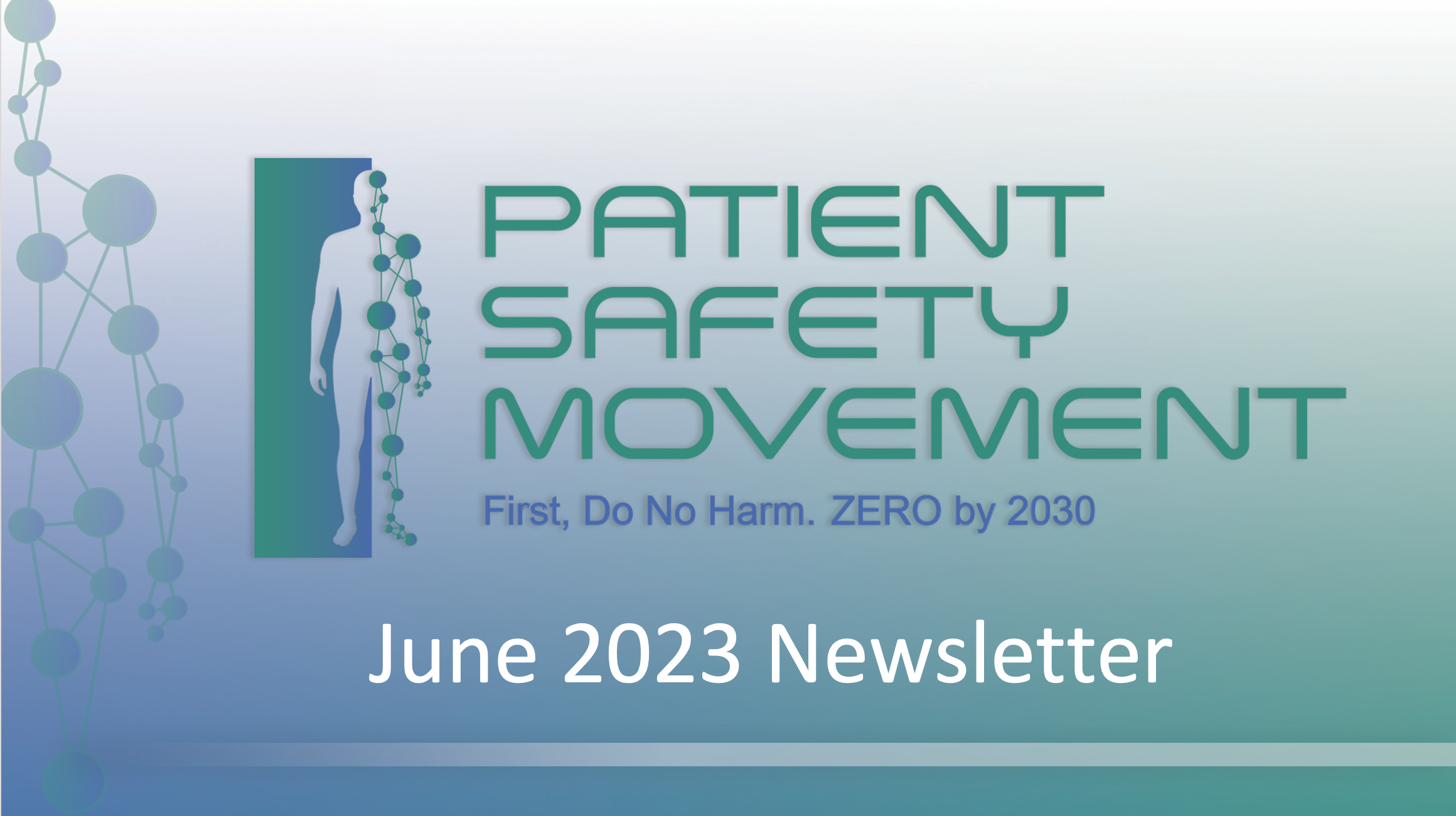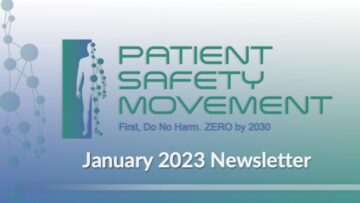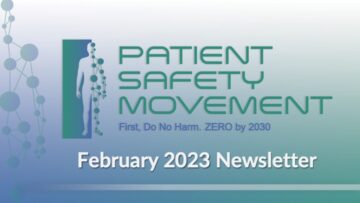Letter from CEO

We are very pleased to report that our first in-person Summit meeting in three years was held in Newport Beach on June 1–2 and was very well attended. The talks and panels were excellent, and there is a YouTube link on our website if you could not make the Summit or you wanted to listen again. President Bill Clinton, the 42nd President of the United States, joined us again and demonstrated his strong commitment to patient safety. We thank him for the strong support and encouragement he has given us over the years. Don Berwick—a global pioneer in patient safety—gave the opening keynote address and set the tone for a very high-quality meeting, both in content and presentation, and this was maintained throughout. In the evening, filmmaker Steve Burrows screened his HBO documentary movie Bleed Out and followed it with a discussion. I would like to thank all those who helped put this Summit together and the volunteers for their hard work and expertise. I would especially like to thank the patients and patients’ families for making this meeting so special, recounting the tragedies that had occurred to their loved ones.
On Monday, June 19, we celebrated “Juneteenth,” an annual commemoration of the end of slavery in the United States. In healthcare, it is an opportunity to look at the state of disparities that exist by race and ethnicity, gender, sexual orientation, gender identity, and disability status, highlighting populations that are disproportionately impacted by inequities. According to the Centers for Disease Control and Prevention and the Commonwealth Fund, the United States has the highest maternal death rate of any developed nation, and Black women are three times more likely to die from a pregnancy-related cause than White women. In the United States, about 6.9 million women have little or no access to maternal health.
We have much to do to make healthcare safe!
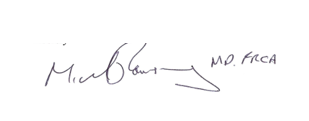
Michael A.E. Ramsay, MD, FRCA, Chief Executive Officer, PSMF
10th Annual World Patient Safety, Science
& Technology Summit Recap
We are extremely grateful to everyone who attended our 10th Annual World Patient Safety, Science & Technology Summit in Newport Beach. The event fostered a high-level exchange of ideas and initiatives to improve global patient safety. Thanks to our expert speakers and panelists, inspiring messages from hospital executives, and the sharing of tragic patient stories, the program ignited further momentum to reach ZERO harm.
The Summit began with a powerful keynote address by Dr. Michael Ramsay, CEO of the Patient Safety Movement Foundation. He reflected on the role the increasing availability of hospital data on medical errors could play in reducing harm. “Technology is changing; we’re now getting real data…. I’m very optimistic that we’re really going to see a difference in healthcare,” he said.
In his State of the Movement Speech, Joe Kiani, founder of the Patient Safety Movement Foundation, emphasized urgency in improving patient safety, praising contributions from individuals and organizations. He also acknowledged the movement’s achievements and called for learning from successful hospitals, transparency, and government support.
Dr. Mike Durkin, chair of the Patient Safety Movement Foundation Board, highlighted the need for improved collaboration in patient safety and the importance of exploring causes and fostering open discussions. He identified the integration of innovative medical technology and devices as crucial for effecting change.
Several distinguished speakers also shared invaluable insights during the Summit:
- President Bill Clinton stressed the importance of learning from others, stating, “We have to develop a culture of conversion, nobody wants to see innocent people die.”
- Dr. Anthony Staines underscored the urgency of making patient safety a global health priority, urging action from countries, institutions, and providers.
- Dr. Jannicke Mellin-Olsen highlighted the significance of patient involvement, advocating for the patient’s voice to be heard at every level of service, even when it may be a whisper.
- Dr. Sanaz Massoumi, the Patient Safety Movement Foundation’s COO, called for a shift in focus, urging healthcare workers to prioritize the quality of care they provide over the sheer volume of cases.
- Dr. Peter Ziese advocated for a preventive approach, suggesting that instead of reacting to issues, we should strive to prevent them.
- Dr. Donald Berwick discussed intentional leadership, asserting that excellence is not accidental but a consequence of deliberate actions.
- Stephanie Mercado redefined the terms “quality” and “safety,” emphasizing that they should no longer be equated with compliance alone but incorporate striving for excellence.
- Dr. Konrad Reinhart called attention to the significant potential to reduce harm in sepsis cases, which currently surpass cancer deaths worldwide.
- Dr. Peter Pronovost discussed the importance of listening to individuals who raise concerns, noting that the majority of harm occurs when these concerns go unheard.
- Dr. Neelam Dhingra expressed belief in the global patient safety movement, which continues to gain strength.
- Dr. Michelle Block Schreiber pointed out that, despite notable advancements in patient safety, the pandemic exposed the fragility and lack of resilience in the healthcare systems across the US.
- Sir Liam Donaldson, MD, defined resilience in the face of threats, stressing the ability of organizations to bend, adapt, and grow to meet new challenges.
- Dr. Francisco Valero-Cuevas reemphasized that the problems and solutions related to patient safety are already known and that existing tools like the Actionable Evidence-Based Practices can be implemented worldwide without the need for further development.
The following panel discussions at the Summit provided an ideal platform for attendees to learn transformative knowledge and strategies from their participants:
Preventing Patient Harm: Predictive Analytics and Artificial Intelligence
Panel participants Nasim Afsar, Philip Lumb, Basil Matta, David Stockwell, and Peter Ziese, with moderator Charlie Miceli, highlighted the transformative potential of AI and predictive analytics in healthcare to enhance patient safety. By leveraging advanced algorithms and machine learning, these technologies can proactively identify risks and prevent adverse events.
President’s Council of Advisors on Science and Technology
PCAST member Joe Kiani moderated a panel with Ruth Ann Dorrill, Rachael Fleurence, Chris Hart, Peter Pronovost, and Sue Sheridan to discuss issues pertaining to the high rates of patient harm in healthcare, as recently addressed by the President’s Council of Advisors on Science and Technology.
The National Patient Safety Board
The National Patient Safety Board panel, featuring moderator Leah Binder and panelists Sir Liam Donaldson, Robert Ferguson, Najmedin Meshkati, Sue Sheridan, and Abby Towfigh, emphasized the need for a national patient safety board to prioritize and raise awareness about patient safety.
Patient Family and Engagement
Panelists Vonda Vaden Bates, Henrietta Hughes, Merope Mills, Sue Sheridan, and Angie Mund, along with moderator Helen Haskell, explored the significance of patient and family involvement in healthcare in this panel. Conversations underscored the government’s role in protecting patient interests and the importance of shared solutions, activism, and advocacy.
The Journey to Zero Harm Panel
Moderator Robin Betts and panelists Kimberly Cripe, Javier Davila, Susan McGrath, and Bill Wilson discussed eliminating preventable harm at large healthcare organizations. Representatives from Children’s Hospital of Orange County and UC Irvine noted the significant improvements their hospitals achieved while acknowledging the ongoing challenges in the wake of the COVID-19 pandemic.
Patient Safety in the News
Panelists Jessica Aguirre, David Cox, Merope Mills, and Diane Perez, with the help of moderator Jim Messina, discussed the vital role of journalists as “influencers” and the importance of unbiased reporting. They shared personal experiences and insights on storytelling techniques to engage readers and create meaningful conversations about healthcare.
Opioid Safety
The opioid safety panel addressed the far-reaching implications of opioids. Moderator Daniel Cole with panelists George Blike, Yvonne Gardner, Grant Lynde, Stacey Orsat, and Frank Overdyk examined the motivations behind opioid prescriptions and advocated for improved education programs and continuous monitoring to detect adverse events.
We extend our heartfelt appreciation to Merope Mills, Melissa Sheldrick, Melissa Pederson, Desiree Williams, and Juwan Lopez for their unwavering commitment to turning personal tragedies into a catalyst for progress. Their voices have ignited a sense of urgency, compelling us to redouble our efforts in the pursuit of safer and more compassionate healthcare systems.
PSMF Fellowship Application
The Global Interprofessional Patient Safety Fellowship application is open until August 1. If you are interested in joining our 2024 cohort, please apply at https://psmf.org/fellowship-application/.

June Is Men’s Health Month
Like Women’s Health Month in May, June’s Men’s Health Month reminds everyone to schedule a regular checkup if it has been one year or longer since the last one. It is also a good time to read up on relevant health topics. For men, these include testicular and prostate health in addition to learning the risks for diabetes, heart disease, and certain cancers as one ages.
Both Women’s and Men’s Health Months encourage everyone to take charge of their overall health by implementing healthy living decisions, particularly those related to diet, activity level, and mental health. During Men’s Health Month, it is worth highlighting that many diseases that disproportionately impact men, like heart disease and cancer, are preventable through regular doctor visits and healthier lifestyle choices. While the life expectancy for men in the US is nearly six years less than for women, non-Hispanic Black and American Indian/Alaska Native men have an even lower life expectancy than non-Hispanic White men.
According to the U.S. Department of Health and Human Services, men are more likely than women to have lower health literacy levels, making it more challenging for them to find, understand, and use information and services that can help them make informed decisions about their health. Men’s Health Month is the perfect opportunity to raise awareness and help men (and women) overcome any gaps in their understanding about potentially life-saving preventable health practices.
National Minority Mental Health Awareness Month
Throughout the month of July, National Minority Mental Health Awareness Month will help bring much-needed awareness to the unique struggles racial and ethnic minority communities in the U.S. face when it comes to their mental well-being.
The COVID-19 pandemic brought new barriers and stigmas to accessing mental health and substance-use treatment that especially impact racial and ethnic minority groups. Emotional distress caused by pandemic-related stressors, such as unemployment, loss of a loved one, and the COVID-19 stigma, could lead to new or worsening mental health issues for anyone. Mental health issues may increase when people face additional stressors and lack access to the resources and support needed to navigate these challenges. Obstacles people from racial and ethnic minority groups may face include lack of or insufficient health insurance, lack of racial and ethnic diversity among mental healthcare providers, lack of culturally competent providers, financial strain, and stigma.
The U.S. Department of Health and Human Services, Office of Minority Health and the CDC are providing information and resources that address mental health issues among racial and ethnic minority populations. The resources are designed to help state, tribal, and local leaders, community-based organizations, faith leaders, healthcare providers, and individuals to educate their communities, reduce stigmas, and improve access to care.
Chairman’s Column
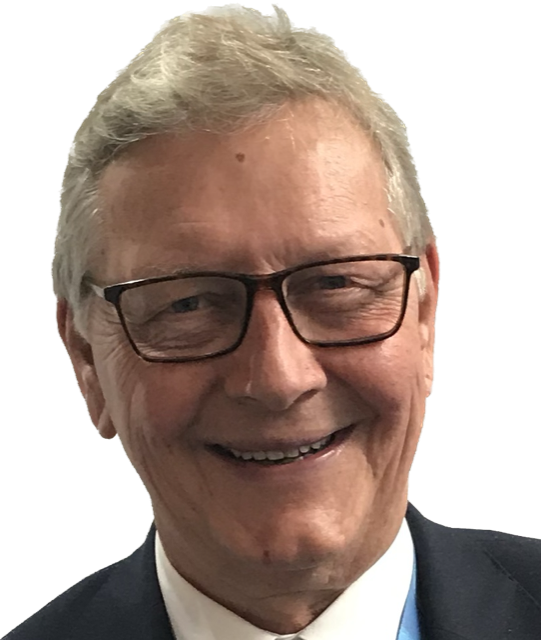
First and foremost, I would like to extend my thanks to the team at the Patient Safety Movement Foundation, led by Mike and Sanaz, for organizing and running a great 10th World Summit in Newport Beach earlier this month. My thanks must also go to our invited speakers, keynote presenters, and panelists for a great two days of debate and information sharing on current and future patient safety priorities that face our patients, healthcare staff, and hospital systems all over the world.
As you will see and have noted, we are also indebted to our funders and sponsors for their continued faith in the Patient Safety Movement Foundation, as we bring to light the challenges facing our hospital systems and medical device industries in ensuring zero harm in healthcare. Covid-19 continues to teach us that healthcare is provided in every element of our lives—hospitals are only one setting—and that the place for safe care is wherever our patients need it and nowhere more so than in our own home setting.
The Summit was such a success also because of the engagement and challenge set by the 400 or so participants. This was our first return to normal conference behavior since 2019, and after blowing away a few cobwebs, we emerged as a group of activists in patient safety able and willing to listen to others, feel and share experiences, often with a lot of pain, but also see hope and a clear sense of direction as we tackle the key tasks to improve the safety of our patients and healthcare staff, both physically and mentally.
Much has been said recently about ensuring that our patients and their families must be at the center of our planning and delivery of healthcare, but as we know from our experience, this is not a universal experience in that our systems have been planned around the needs of our providers rather than our patients. The Summit highlighted the need to address this deficit on a number of occasions with “presidential” deliveries demanding change in the hierarchy and paradigm of healthcare delivery.
Outstanding addresses and very challenging panel sessions were the order of the day across two very busy days, and for those who attended the screening of Bleed Out, we got a stark reminder of just how much still needs to be done to address behavior and power dynamics in our systems.
I cannot resist name checking the panels on patient engagement, AI, and the media, but all the panels and addresses from keynotes and featured speakers are worth second and third viewings (via our YouTube channel) when time permits. These presentations offer more than just gold dust but whole nuggets of wise words, great council, and future challenges to our healthcare, civic, and political leaders to take note and implement change.
Our Summit is now firmly back on the annual agenda, not just as a moment in time but as a stepping stone for us to continue to build momentum for change and improvement in every element of our pathway to reduce harm to ZERO.
I look forward to meeting again next year at the 11th World Summit on Patient Safety, Science & Technology.
Yours,

Mike Durkin, OBE, MBBS, FRCA, FRCP, DSC
Innovation Corner*
Simplified Labeling to Help Make Intravenous Lines Safer
Despite technological advances with intravenous infusion pumps, barcode technology, and automated pharmacy dispensing systems, up to 50% of patients receiving IV medication will experience a medication error during a hospital stay.(1) Up to 56% of these errors are related to incomplete or incorrect IV line labeling.(2) Sāfen® has developed a low-technology communication system that uses tags to quickly and intuitively help healthcare workers, patients, and their caregivers identify medications infusing through intravenous lines. Rapidly identifying IV medications and fluids is extremely important during emergencies, such as Code Blue or Rapid Response situations.
1. Medication Administration Errors (2021). Retrieved from https://psnet.ahrq.gov/primer/medication-administration-errors
2. Summa-Sorgini, C., Fernandes, V., Lubchansy, S., Mehta, S., Hallet, D., Bailie, T., Lapinsky, S., Burry, L. (2012). Errors Associated with IV Infusions in Critical Care. The Canadian Journal Hospital Pharmacies. 65(1).
*Patient Safety Movement Foundation does not endorse any specific commercial products, services, or companies. Information included in this section is merely to share the technologies that may improve patient safety.
In the News
- A front-page story in The San Diego Union-Tribune profiled the work of San Diego State University alum Joe Kiani on the occasion of the 10th Annual World Patient Safety, Science & Technology Summit.
- The governor of Texas recently signed into law a major patient safety bill with bipartisan support and input from patient advocates. The bill reforms the Texas Medical Board to better protect patients from potentially dangerous doctors, as reported by Austin’s KXAN (NBC) News.
- ABC News aired an in-depth report on the dangers posed to patient safety by the growing number of cybersecurity attacks on hospitals.
- A new report from The Leapfrog Group and Urban Institute shows that racial disparities in patient safety persist even at the highest-performing hospitals, as posted on PatientEngagementHIT.
- A medication dispensing error at a DC-area nursing home with a history of such errors almost cost a 75-year-old woman her life, as reported by ABC 7 News in Washington, DC.
- NBC News reported that a Colorado surgeon was found guilty of manslaughter in the death of a teen patient who went into a coma during breast augmentation surgery and died a year later.
- The death last month of Olympic track-and-field gold medalist Tori Bowie, while in childbirth, highlights the elevated risk Black women face for preeclampsia and eclampsia, according to a report by NPR.
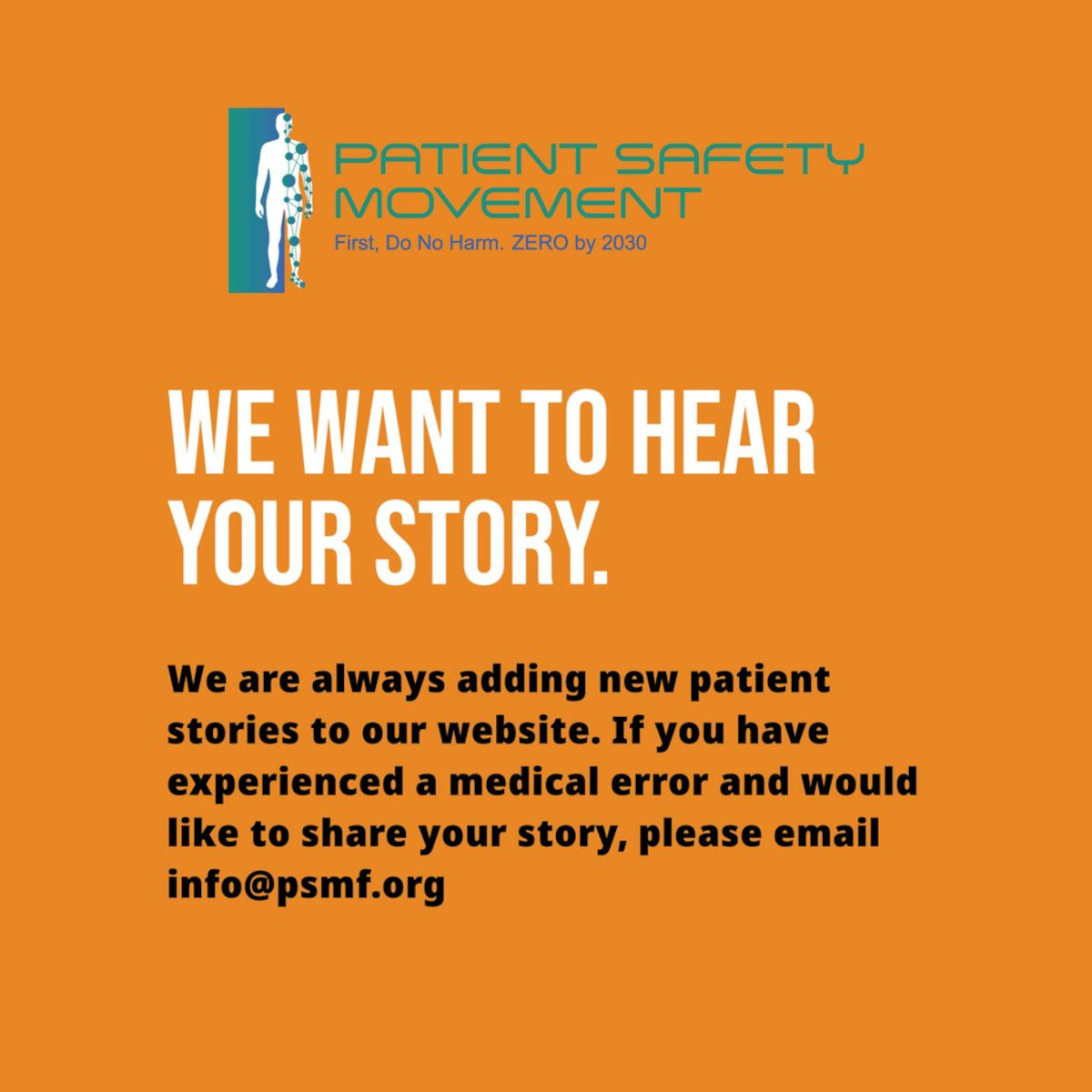
DONOR TESTIMONIALS — WHY I GIVE

GOVERNANCE BOARD
Mike Durkin, OBE, MBBS, FRCA, FRCP, DSC, Chairman of PSMF, Senior advisor on Patient Safety Policy and Leadership, Institute of Global Health Innovation, Imperial College London
Steven J. Barker, PhD, MD, Chief Science Officer, Masimo Corporation, Professor Emeritus of Anesthesiology, University of Arizona Health Sciences
Robin Betts, RN, CPHQ, MBA-HA, Vice Chair, PSMF, Vice President, Safety Quality & Regulatory Services, Kaiser Foundation Hospitals and Health Plan, Kaiser Permanente Northern California
Alicia Cole, Patient Safety Consultant
Javier T. Davila, MD, MFS, Ambassador, PSMF in Mexico, Former Medical Director, Mexican Social Security Institute, Head of Medical Education, Research and Health Public Policy
Omar Ishrak, PhD, Executive Chairman and Chairman of the Board of Directors, Medtronic, Chairman of the Board of Directors, Intel
Philip D. Lumb, MB, BS, MD, MCCM, FCCP, Professor of Anesthesiology and Trauma Surgery, Keck School of Medicine at University of Southern California
Joe Kiani, Founder and Immediate Past Chairman of PSMF, Founder, Chairman & CEO of Masimo
Sarah Kiani, Director, Masimo Foundation for Ethics, Innovation, and Competition
David B. Mayer, MD, Executive Director, MedStar Institute for Quality and Safety
Jannicke Mellin-Olsen, MD, DPH, Past President, World Federation of Societies of Anesthesiologists
Jim Messina, CEO, The Messina Group
Najmedin Meshkati, Ph.D, MS, Professor of Civil/Environmental Engineering, University of Southern California
Charlie Miceli, CPM, Treasurer, PSMF, Chief Supply Chain Officer, Network VP of University of Vermont Health Network
Michael A.E. Ramsay, MD, FRCA, Chief Executive Officer, PSMF
Abbasseh Towfigh, MPD, Executive Director and Secretary, Ayeneh Foundation
Vonda Vaden Bates, Patient Advocate, CEO, 10th Dot
OUR STORY
 In 2012, Joe Kiani founded the nonprofit Patient Safety Movement Foundation (PSMF) to eliminate preventable medical errors in hospitals. His team worked with patient safety experts from around the world to create Actionable Evidence-Based Practices (AEBP) that address the top challenges. The AEBP is available without charge to hospitals online.
In 2012, Joe Kiani founded the nonprofit Patient Safety Movement Foundation (PSMF) to eliminate preventable medical errors in hospitals. His team worked with patient safety experts from around the world to create Actionable Evidence-Based Practices (AEBP) that address the top challenges. The AEBP is available without charge to hospitals online.
Hospitals are encouraged to make a formal commitment to ZERO preventable deaths, and healthcare technology companies are asked to sign the Open Data Pledge to share their data so that predictive algorithms that can identify errors before they become fatal can be developed. The Foundation’s annual World Patient Safety, Science & Technology Summit brings together all stakeholders, including patients, healthcare providers, medical technology companies, government employers, and private payers. The PSMF was established through the support of the Masimo Foundation for Ethics, Innovation, and Competition in Healthcare. For more information, please visit psmf.org.

